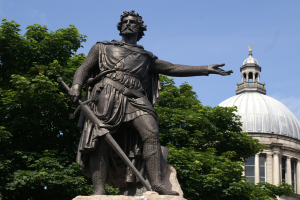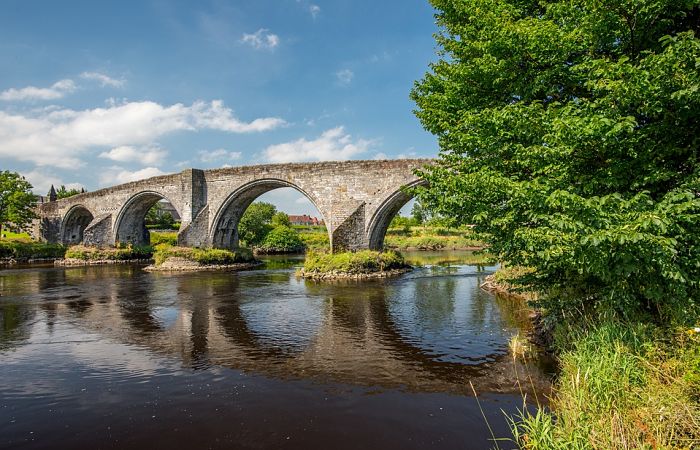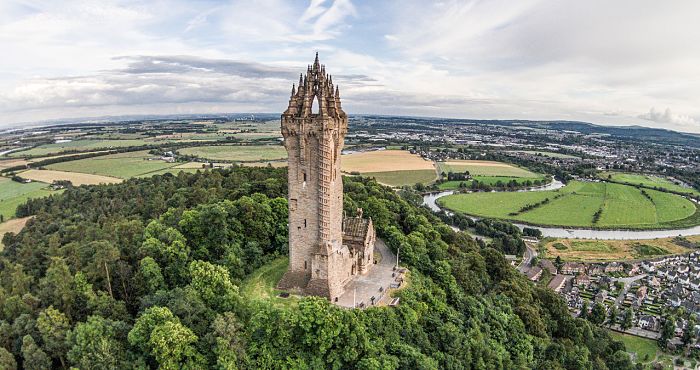Reputed to have been born in Elderslie in the 1270s, William Wallace was a freedom fighter for Scotland and Ireland against England, near the end of the 13th century.
 My interest in Scottish history had something of a major resurgence following the 1995 movie “Braveheart”, which, although enjoyable, was not historically exact. But, as you would expect in a Hollywood production, fact and fiction were somewhat distorted for the sake of drama, and in one instance, impossible.
My interest in Scottish history had something of a major resurgence following the 1995 movie “Braveheart”, which, although enjoyable, was not historically exact. But, as you would expect in a Hollywood production, fact and fiction were somewhat distorted for the sake of drama, and in one instance, impossible.
William Wallace: The Facts
The implication that Wallace was the father of Edward III, born to Isabella of France, following an affair, was far off the mark, considering that Isabella was only 10 years old when Wallace died, and Edward III wasn’t born until 7 years after Wallace’s death.
Getting back to the facts, Wallace was brought up by his uncle in Dunipace, after his father died when he was a boy. He was to continue his father’s fight and he raised an army against King Edward I of England. King Edward had dismissed any talk of Scottish Independence, and viewed Wallace as an outlaw. Rebellion followed, and many men joined forces with Wallace as he began to drive the English out of Perthshire and Fife.
In May 1297, He attacked the town of Lanark, killing the English sheriff, to avenge the death of Marion Braidfute of Lamington, (the woman who became his wife in the film).
THE BATTLE OF STIRLING BRIDGE
Much blood was spilled up to, and after the famous Battle of Stirling Bridge in 1297.

It took place on the 10th September, and Wallace and his men, heavily outnumbered, had occupied the high ground of Ochil Hills, forcing Edward’s army to fight uphill.
One last plea from the King’s spokesman, asking Wallace to surrender was met with defiance, with Wallace replying :
“Tell your king that William Wallace will NOT be ruled. Lower your flags and march straight back to England, stopping at every home to beg forgiveness for a hundred years of theft, rape, and murder.”
William Wallace was victorious, and in December of 1297, he was elected Guardian of the Kingdom and uncrowned ruler of Scotland. He assembled his army on Roslin Moor, marched south into Northumberland, and meticulously ravaged the counties of Durham, Northumbria, and Cumbria, taking anything of value back over the border.
A further raid took place in ‘the Barns of Ayr’ with Wallace setting fire to the camp, and burning 500 English soldiers in a revenge attack for the murder of his uncle.
The English King brought a large army to Falkirk in May the following year, 1298, and goaded Wallace into fighting a second battle. This time Wallace was defeated and in September resigned as Guardian of Scotland in favour of Robert the Bruce.
He fled to France in 1299.
He returned from France in 1303, and evaded capture by the English until 5 August 1305. His capture was the result of an act of betrayal by John de Menteith, a Scottish knight loyal to Edward, who turned him over to English soldiers at Robroyston.
Wallace was first taken to Dumbarton Castle, and then to London under heavy guard, and tried for treason. He was then ceremoniously paraded through the streets of the city, like some sort of trophy. He was sentenced to be hung, drawn and quartered.
His head was put on a pike at the top of London Bridge, and his limbs were displayed separately, in Newcastle, Berwick, Stirling, and Aberdeen. King Edward hoped that this public display would deter all insurgents, but one Robert the Bruce had other ideas.
The Bruce family had no connection with the capture of Wallace, and Robert The Bruce, who had previously been fuelled by his own ambition, was now ready to play his part in the struggle to maintain Scotland’s independence from English rule.
The Bruce’s finest hour was to come in 1314 at the Battle of Bannockburn, when he was victorious over Edward’s army, despite being heavily outnumbered, three to one.
THE WALLACE MONUMENT
The Wallace Monument, located just outside Stirling, was completed in 1869 on the Abbey Craig, where Wallace had watched the English army gather at Stirling Bridge.

The monument has a visitor pavilion with a coffee shop and gift shops, plus there’s free car parking available. You can also enjoy an audio tour which lets you re-live Wallace’s life and trial, and the Wallace sword is on display here.
“It’s all for nothing if you don’t have freedom”
William Wallace
FOOTNOTE: For many years after the exploits of Wallace and Robert The Bruce, the nation fought on, refusing to accept English rule right up until the year 1707, when the Acts of Union brought the countries together, creating the Kingdom of Great Britain.
READ MORE SCOTTISH HISTORY….